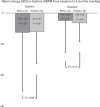Renal denervation in treatment-resistant essential hypertension. A randomized, SHAM-controlled, double-blinded 24-h blood pressure-based trial
- PMID: 27228432
- PMCID: PMC4933576
- DOI: 10.1097/HJH.0000000000000977
Renal denervation in treatment-resistant essential hypertension. A randomized, SHAM-controlled, double-blinded 24-h blood pressure-based trial
Abstract
Background: Renal denervation (RDN), treating resistant hypertension, has, in open trial design, been shown to lower blood pressure (BP) dramatically, but this was primarily with respect to office BP.
Method: We conducted a SHAM-controlled, double-blind, randomized, single-center trial to establish efficacy data based on 24-h ambulatory BP measurements (ABPM). Inclusion criteria were daytime systolic ABPM at least 145 mmHg following 1 month of stable medication and 2 weeks of compliance registration. All RDN procedures were carried out by an experienced operator using the unipolar Medtronic Flex catheter (Medtronic, Santa Rosa, California, USA).
Results: We randomized 69 patients with treatment-resistant hypertension to RDN (n = 36) or SHAM (n = 33). Groups were well balanced at baseline. Mean baseline daytime systolic ABPM was 159 ± 12 mmHg (RDN) and 159 ± 14 mmHg (SHAM). Groups had similar reductions in daytime systolic ABPM compared with baseline at 3 months [-6.2 ± 18.8 mmHg (RDN) vs. -6.0 ± 13.5 mmHg (SHAM)] and at 6 months [-6.1 ± 18.9 mmHg (RDN) vs. -4.3 ± 15.1 mmHg (SHAM)]. Mean usage of antihypertensive medication (daily defined doses) at 3 months was equal [6.8 ± 2.7 (RDN) vs. 7.0 ± 2.5 (SHAM)].RDN performed at a single center and by a high-volume operator reduced ABPM to the same level as SHAM treatment and thus confirms the result of the HTN3 trial.
Conclusion: Further, clinical use of RDN for treatment of resistant hypertension should await positive results from double-blinded, SHAM-controlled trials with multipolar ablation catheters or novel denervation techniques.
Figures
Comment in
-
Renal denervation for resistant hypertension: closing in on potential confounders.J Hypertens. 2016 Aug;34(8):1505-6. doi: 10.1097/HJH.0000000000001016. J Hypertens. 2016. PMID: 27356001 No abstract available.
Similar articles
-
The effect of renal denervation in moderate treatment-resistant hypertension with confirmed medication adherence.J Hypertens. 2016 Dec;34(12):2475-2479. doi: 10.1097/HJH.0000000000001110. J Hypertens. 2016. PMID: 27607458
-
The effect of renal denervation on arterial stiffness, central blood pressure and heart rate variability in treatment resistant essential hypertension: a substudy of a randomized sham-controlled double-blinded trial (the ReSET trial).Blood Press. 2017 Dec;26(6):366-380. doi: 10.1080/08037051.2017.1368368. Epub 2017 Aug 23. Blood Press. 2017. PMID: 28830251 Clinical Trial.
-
Renal denervation in moderate treatment-resistant hypertension.J Am Coll Cardiol. 2013 Nov 12;62(20):1880-6. doi: 10.1016/j.jacc.2013.06.023. Epub 2013 Jul 10. J Am Coll Cardiol. 2013. PMID: 23850901 Clinical Trial.
-
Effects of renal denervation on blood pressure in patients with hypertension: a latest systematic review and meta-analysis of randomized sham-controlled trials.Hypertens Res. 2024 Oct;47(10):2745-2759. doi: 10.1038/s41440-024-01739-y. Epub 2024 Jun 3. Hypertens Res. 2024. PMID: 38831091
-
The effect of catheter-based sham renal denervation in hypertension: systematic review and meta-analysis.BMC Cardiovasc Disord. 2023 May 12;23(1):249. doi: 10.1186/s12872-023-03269-w. BMC Cardiovasc Disord. 2023. PMID: 37173636 Free PMC article.
Cited by
-
ReferencesEfficiency and safety of renal denervation via cryoablation (Cryo-RDN) in Chinese patients with uncontrolled hypertension: study protocol for a randomized controlled trial.Trials. 2019 Nov 28;20(1):653. doi: 10.1186/s13063-019-3693-9. Trials. 2019. PMID: 31779672 Free PMC article.
-
Selective vs. Global Renal Denervation: a Case for Less Is More.Curr Hypertens Rep. 2018 May 1;20(5):37. doi: 10.1007/s11906-018-0838-2. Curr Hypertens Rep. 2018. PMID: 29717380 Review.
-
Celiac ganglia neurolysis suppresses high blood pressure in rats.Hypertens Res. 2023 Jul;46(7):1771-1781. doi: 10.1038/s41440-023-01305-y. Epub 2023 May 12. Hypertens Res. 2023. PMID: 37173429
-
Renal Denervation Effects on Blood Pressure in Resistant and Uncontrolled Hypertension: A Meta-Analysis of Sham-Controlled Randomized Clinical Trials.Clin Cardiol. 2025 Mar;48(3):e70104. doi: 10.1002/clc.70104. Clin Cardiol. 2025. PMID: 40022571 Free PMC article.
-
Randomized Blinded Placebo-Controlled Trials of Renal Sympathetic Denervation for Hypertension: A Meta-Analysis.Cardiovasc Revasc Med. 2022 Jan;34:112-118. doi: 10.1016/j.carrev.2021.01.031. Epub 2021 Jan 30. Cardiovasc Revasc Med. 2022. PMID: 33551282 Free PMC article.
References
-
- Krum H, Schlaich MP, Sobotka PA, Böhm M, Mahfoud F, Rocha-Singh K, et al. Percutaneous renal denervation in patients with treatment resistant hypertension: final 3-year report of the Symplicity HTN-1 study. Lancet 2014; 383:622–629. - PubMed
-
- Böhm M, Mahfoud F, Ukena C, Hoppe UC, Narkiewicz K, Negoita M, et al. First report of the Global SYMPLICITY Registry on the effect of renal artery denervation in patients with uncontrolled hypertension. Hypertension 2015; 65:766–774. - PubMed
-
- Sarafidis P, Bakris G. Resistant hypertension. An overview of evaluation and treatment. J Am Coll Cardiol 2008; 52:1749–1757. - PubMed
-
- Calhoun DA, Jones D, Textor S, Goff DC, Murphy TP, Toto RD, et al. Resistant hypertension: diagnosis, evaluation, and treatment. A scientific statement from the American Heart Association Professional Education Committee of the Council for High Blood Pressure Research. Hypertension 2008; 117:510–526. - PubMed
Publication types
MeSH terms
Substances
Supplementary concepts
LinkOut - more resources
Full Text Sources
Other Literature Sources
Medical


